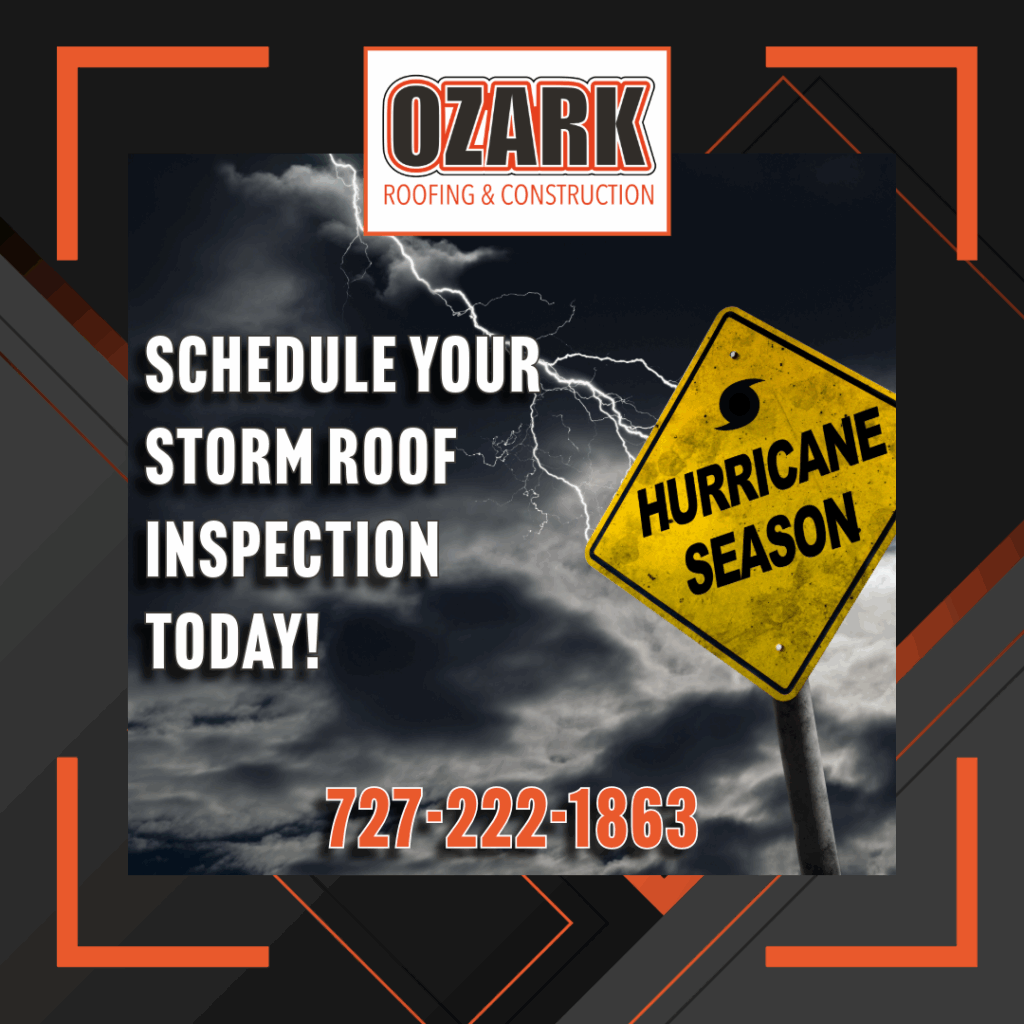
Your 48-Hour Action Plan After the Storm Passes
When the winds die down and the last raindrops fall, Florida homeowners face a critical window of opportunity. The next 48 hours after a storm can make the difference between minor repairs and major reconstruction, between a quick insurance claim and a lengthy dispute, between protecting your home and watching small problems become catastrophic failures.
At Ozark Roofing, we’ve helped countless St. Petersburg and Tampa Bay families navigate the aftermath of Florida’s notorious storms. From tropical storms to hurricanes, we’ve seen how proper post storm inspection and documentation can save homeowners thousands of dollars and months of headaches.
Here’s your complete guide to conducting a thorough post-storm roof inspection, because in Florida’s climate, storm damage doesn’t wait, and neither should you.
Why the First 48 Hours are Critical
Time is not on your side after a storm.
Rapid Deterioration in Florida’s Climate:
Florida’s heat, humidity, and frequent afternoon thunderstorms can turn minor storm damage into major problems within days. A small leak becomes a mold problem. A loose shingle becomes a missing shingle. A damaged flashing becomes interior flooding.
Insurance Claim Requirements:
Most insurance companies require storm damage to be reported within 48-72 hours. Delays can complicate your claim or even result in denial. Early documentation is crucial for proving that damage occurred during the covered storm event.
Contractor Availability
After major storms, qualified roofing contractors become extremely busy. The sooner you identify and document damage, the faster you can secure professional repairs before the rush beings.
Preventing Secondary Damage
Storm damage rarely stays contained. What starts as a minor roof issue can quickly spread to your home’s interior, HVAC system, electrical components, and structural elements if not address promptly.
Exterior Inspection Checklist: From the Ground
Start your inspection safely from ground level using binoculars. This initial assessment helps you determine whether it’s safe to get closer or if you need immediate professional help
Roofing Materials Assessment
Missing, cracked, or displaced shingles:
- Asphalt shingles: Look for completely missing shingles, cracked or split shingles, or shingles that have lifted or shifted position
- Tile roofing: Check for cracked, broken, or displaced tiles, especially along edges and ridges
- Metal Roofing: Inspect for dents, scratches, loose panels, or areas where fasteners have failed
- Flat roofing: Look for tears, punctures, or areas where membrane has lifted or separated.
What to document: Take photos of any damaged areas, noting their location relative to landmarks like chimneys or windows.
Critical Flashing Points
Check for damaged flashings around:
- Chimneys: Check where roofing meets masonry for gaps, cracks, or separated flashing
- Vents: Inspect pipe boots and vent flashing for cracks or separation
- Skylights: Look for damaged or missing flashing around skylight frames
- Dormers: Check where dormers meet the main roof line
- Roof valleys: Inspect valley flashing for damage or debris accumulation
When this matters: Flashing failures are responsible for 90% of roof leaks. Even minor flashing damage can lead to significant water intrusion.
Drainage System Evaluation
Check for clogged or Damaged Gutters and Downspouts:
- Gutters: Look for sections that are bent, separated, or completely detached
- Downspouts: Check for dents, disconnections, or areas where water isn’t flowing properly
- Gutter guards: Inspect for damage or excessive debris buildup
- Drainage flow: Look for areas where water pooled or created erosion patterns
Immediate concerns: Clogged gutters can cause water to back up under roofing materials, leading to leaks and structural damage.
Structural and Surface Damage
Check for Dents in Metal Roofing or siding:
- Hail damage: Look for circular dents or dings in metal surfaces
- Impact damage: Check for areas where debris struck metal components
- Fastener damage: Inspect for loose or missing screws and fasteners
- Paint damage: Note areas where protective coatings have been compromised
Debris Assessment:
- Lodged debris: Look for branches, leaves, or other materials stuck in roof valleys or against structures
- Heavy debris: Note any large items that may have caused impact damage
- Accumulated debris: Check for excessive buildup that could cause drainage problems.
If Safe to Access Roof: Detailed Inspection
Only proceed with roof access if you’re experienced, conditions are completely safe, and you have proper safety equipment. When in doubt, hire professionals.
Surface-Level Damage
Check for Loose or Exposed Nails:
- Nail pops: Look for nails that have worked their way up through shingles
- Missing nails: Check for areas where fasteners have completely pulled out
- Exposed fasteners: Inspect for nails or screws that are no longer covered by roofing material
- Rust or corrosion: Note any fasteners showing signs of deterioration
Check for Granule Loss on Asphalt Shingles:
- Excessive granule loss: Look for shingles with significant bare spots
- Granule accumulation: Check gutters for excessive granule buildup
- Uniform vs localized loss: Determine if granule loss is storm-related or age-related
- Color changes: Note areas where granule loss has exposed different color backing
Tile and Specialty Roofing Issues
Check for Cracked or Broken Tiles:
- Hairline cracks: Look for small cracks that could worsen over time
- Complete breaks: Document tiles that are completely broken or missing pieces
- Loose tiles: Check for tiles that move when touched or have separated from fasteners
- Underlayment exposure: Look for areas where broken tiles have exposed underlayment
Critical Penetration Points
Check for Damaged Roof Penetrations:
- Vent pipes: Check pipe boots for cracks, tears, or separation from roofing
- Exhaust vents: Inspect housing and flashing for damage
- Satellite dishes: Look for loose mounting or damaged flashing
- HVAC equipment: Check for damage to units or associated penetrations
Interior Red Flags: Signs of Water Intrusion
Don’t forget to inspect inside your home, interior signs often reveal damage that’s not visible from outside.
Immediate Water Damage Indicators
Check for Water Stains on Ceilings or Walls:
- Fresh stains: Look for dark, wet spots or discoloration
- Ring patterns: Check for circular stains indicating ongoing leaks
- Expanding stains: Note any stains that appear to be growing
- Multiple locations: Document all areas showing water damage
Check for Active Leaks:
- Dripping sounds: Listen for water dripping inside walls or ceilings
- Visible leaks: Look for water actively entering your home
- Pooling water: Check for water accumulation on floors or surfaces
- Wet insulation: Inspect attic areas for saturated insulation
Hidden Moisture Problems
Musty Odors Indicating Hidden Moisture:
- Attic odors: Inspect upper areas for signs of trapped moisture
- Wall cavities: Note any unusual odors that could indicate hidden leaks
- HVAC System: Check for musty smells from air conditioning or heating vents
Structural Concerns
Check for Sagging Ceiling areas:
- Visible sagging: Look for areas where ceilings appear to bow or droop
- Texture changes: Check for areas where ceiling texture appears different
- Cracks: Inspect for new cracks in ceiling or wall surfaces
- Separation: Look for areas where ceiling meets walls showing gaps
Common Post-Storm Mistakes to Avoid
Delaying Action: Waiting too long to inspect or report damage allows problems to worsen and can complicate insurance claims.
Inadequate Documentation: Poor photos or incomplete records can result in claim disputes or reduced settlements.
Unsafe Inspection Practices: Taking unnecessary risks can result in injury and additional property damage
Accepting Quick Fixes: Temporary repairs that become permanent often fail and cause more extensive damage.
Not Using License Contractors: Hiring unlicensed or uninsured contractors can void warranties and create liability issues.
Why Professional Roof Inspection Matters
While homeowner inspection is crucial for immediate assessment and insurance documentation, professional inspection provides:
Expert Damage Assessment
Experienced roofers can identify damage that untrained eyes might miss including:
- Hidden structural damage
- Compromised waterproofing systems
- Code compliance issues
- Long-term durability concerns
Insurance Claim Support
Professional contractors can:
- Provide detailed damage reports for insurance companies
- Work directly with adjusters to ensure proper claim handling
- Supplement homeowner documentation with technical expertise
- Advocate for complete repairs rather than partial fixes
Proper Repair Planning
Professional assessment ensures:
- Comprehensive repair scope addressing all damage
- Code-compliant solutions that pass inspections
- Warranty protection for materials and workmanship
- Long-term performance rather than quick fixes
Storm Damage Worsens Quickly in Florida’s Climate
Florida’s unique climate means that storm damage doesn’t stay static. Heat, humidity, and frequent weather changes accelerate deterioration, turning minor issues into major problems within days or week.
Every day you wait:
- Water damage spreads deeper into your home’s structure
- Mold growth begins in as little as 24-48 hours
- Secondary damage affects more of your home
- Repairs costs increase exponentially
- Insurance complications become more likely
Protect your Home with a Professional Storm Damage Assessment
At Ozark Roofing, we understand the urgency of post-storm situations. As a locally owned business serving St. Petersburg and Tampa Bay, we’ve helped hundreds of homeowners navigate storm damage recovery, ensuring complete and proper repairs.
Contact Ozark Roofing immediately after any storm:
- Emergency Line: 727-222-1863 Or
- Schedule online through link below.
Our experienced team is ready to respond quickly, assess damage accurately, and restore your roof to better-than-before condition. When storms strike, every hour counts. Trust Ozark Roofing to protect your home and your family with fast, professional storm damage restoration.



